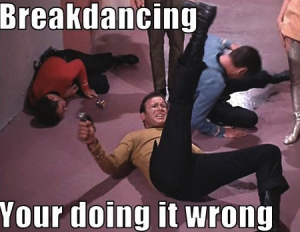Earlier this year I dove into the joint by joint approach and how it affects the ankles and knees. While my intentions were good natured, focusing purely on one aspect of a single joint and all of its intricacies may have been too intense for a simple blog post.
However, it is still foolhardy to not appreciate the simplicity of this approach.

Most recently I had the pleasure of discussing this approach and helping the Temple Bboys understand this idea better, that if you lose requisite mobility (or don’t maintain mobility) in certain joints, there will be a loss of motion above or below the affected joint.
“The process is simple…
-Lose ankle mobility, get knee pain
-Lose hip mobility, get low back pain
-Lose thoracic mobility, get neck and shoulder pain, or low back pain
-Looking at the body on a joint-by-joint basis beginning with the ankle, this makes sense.” Advances in Functional Training, Mike Boyle)
While pain might not be the immediate conclusion in those with limited ankle mobility, over time if there is enough of a repetitive load placed on an immobile or restricted joint, one must wonder what kind of structural parts of the joint (or those surrounding it) are being overused and/or being underused at the same time.
The interesting thing is – how does this apply to dancing? And how does this apply to injuries?
While what dancers do can be described as magical and transformative, this is merely a metaphorical definition of what they can do and how they can make others feel. Dancers are human, and until they develop a third arm that can functionally change the game, I will approach every dancer the same!
With this being said, dancers may have a lack of stability in certain joints, while displaying larger degrees of mobility at varying joints (everyone is different).
So if a dancer presents with excessive lumbar mobility, expect issues with the hips and/or thoracic junction (which can affect the scapula, shoulder joint, and even neck).
Likewise, if they do not have control of that excess lumbar mobility, I do not expect rotation at the hips to be controlled to the degree that they need to be controlled at while performing movements such as the windmill, flares, or even a simple move such as swipes.
[youtube=http://www.youtube.com/watch?v=iieTCVhr4As]
Where stability meets mobility.
While this issue of a lack of stability/mobility may be present throughout the body, it won’t be present until a full body movement assessment is performed on said individual dancer. This is merely one blog post glossing over the idea of the JBJA.
One person can have mobility issues because they perform coindrops to only one side. Or another person can have a lack of stability at the shoulder joint due to a lack of mobility in the scapula, which can affect their ability to perform airchairs or one handed freezes.

So what does this mean to
bboys across the board?
So with regards to injuries, the stability and mobility overlap described above can certainly interface with injuries, due to movement being acquired from elsewhere in the kinetic chain (prime muscle movers not working as efficiently due to a lack of stabilization pattern, and thus recruiting other synergistic or accessory muscle groups to pick up the slack).
First of all, my first order of business is the restoration of a limited movement pattern, which can be identified through a formal movement assessment (whether you like FMS, PRI, or other orthopedic tests is up to you).
Secondly, my next goal is to solidify these movement patterns that have been restored through strength training while keeping this approach in mind. This reconfirms and should solidify for you as well the notion that isolation training (in the gym) is not the most ideal scenario for dancers.
My ideal situation involves:
- Full Body Movement Assessment (To discover potential or problematic areas)
- Breathing Pattern Repositioning
- Inhibition of Tonic Musculature (Self-Myofascial Release or Foam Rolling)
- Dynamic Warm-Up (Full body warm-up abiding by the JBJA)
- Strength Training in a Variety of Healthy Movement Patterns
…and if possible - Soft Tissue Management/Treatment by Licensed Professional
- Nutritional Guidance and Supplemental Choices (aka not drinking beer everyday)
This approach should be notified as remarkably different than what many bboys (or even dancers in general) may be accustomed to, primarily because there is no mention of physical therapy practice or otherwise to restoring movement. (I don’t claim to be a physical therapist.)
The reason being that I push this approach, besides the fact that I get to work with bboys more intimately, is that there is a large lack of health insurance that bboys do not get the pleasure of receiving. (While this discussion can easily take a dive down the socio-economic problems that affect a certain population of athletes and dancers, I will avoid that discussion for now.) This means bboys won’t necessarily get access to the cream of the crop of physical therapists out there.
Many of these soft tissue problems can be resolved via appropriate self-maintenance utilizing the generalized tools above, and understanding what your specific body needs. If you can manage that, or let a competent coach see how your body moves, there is no reason why you cannot continue to dance longer, faster, and harder than you are currently dancing utilizing these principles of basic human movement.
As always…
Keep it funky.
MA
